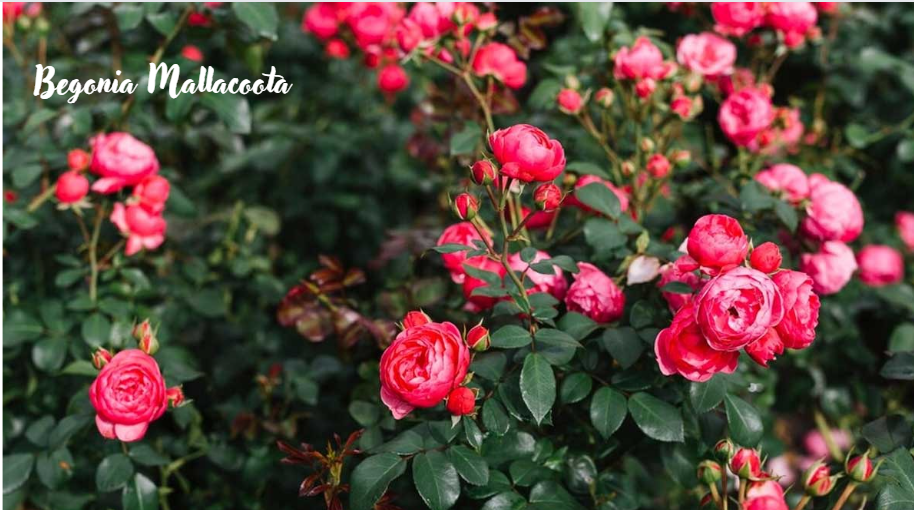The Begonia Mallacoota is a gem among houseplants for gardening enthusiasts, particularly for those in the USA. This delightful plant is known for its lush, vibrant foliage and ease of care. If you’re looking to add a unique, low-maintenance, yet visually appealing plant to your indoor garden, the Begonia Mallacoota is a perfect choice.
While there are many articles about begonias, this comprehensive guide will explore the care, characteristics, and lesser-known facts about Begonia Mallacoota in a way that goes beyond typical sources. We will also share tips, unique insights, and common issues faced by gardeners.
Contents
- 1 1. Introduction to Begonia Mallacoota
- 2 2. Origins and History of the Begonia Mallacoota
- 3 3. Physical Characteristics of the Begonia Mallacoota
- 4 4. Growing Conditions for Begonia Mallacoota
- 5 5. How to Plant and Propagate Begonia Mallacoota
- 6 6. Common Problems and Solutions
- 7 7. Special Tips for Indoor Care
- 8 8. Benefits of Growing Begonia Mallacoota Indoors
- 9 9. Seasonal Care for Begonia Mallacoota
- 10 10. Decorative Uses of Begonia Mallacoota
- 11 11. Frequently Asked Questions (FAQs)
- 12 conclusion
1. Introduction to Begonia Mallacoota
The Begonia Mallacoota is a hybrid variant of the Begonia plant family, which consists of more than 1,800 species. It is renowned for its stunning foliage and bright colors, which can range from deep green to striking shades of red and pink. Unlike some more delicate houseplants, the Begonia Mallacoota thrives with minimal attention, making it a great addition to any home. Indoor gardeners particularly love this plant because of its adaptability to different environments and its ability to flourish in indirect sunlight.
Though native to tropical climates, it has become popular across the world, especially in the USA, where indoor gardening has surged in popularity. The combination of easy maintenance and the aesthetic value of this begonia species makes it a standout option for both beginner and experienced gardeners alike.
2. Origins and History of the Begonia Mallacoota
The name “Begonia” was first coined by botanist Charles Plumier in honor of Michel Bégon, a French governor and plant enthusiast. Begonias are native to tropical and subtropical regions such as South America, Africa, and parts of Asia. However, the Begonia Mallacoota itself is a hybrid species that was cultivated to suit the needs of indoor environments.
This particular hybrid is believed to have originated from breeders who wanted a hardier, more vibrant version of traditional begonias. While not as old as some plant species, the Begonia Mallacoota has quickly gained popularity due to its attractive foliage and relatively easy care routine.
3. Physical Characteristics of the Begonia Mallacoota
The Begonia Mallacoota is highly valued for its decorative leaves. Unlike many other houseplants, its beauty lies primarily in its foliage rather than flowers. Here are some distinguishing features:
- Leaves: The leaves are large, asymmetrical, and come in varying shades of green, red, or silver. They often have intricate patterns or veins running through them, adding to their ornamental value.
- Flowers: While the leaves are the star of the show, the Begonia Mallacoota can also produce small flowers. These flowers are usually white or light pink and grow in clusters, though they are less prominent than the foliage.
- Size: The plant typically grows to about 12-18 inches in height and can spread to about 24 inches if well-cared for.
The texture of the leaves is slightly waxy, which not only adds to the plant’s visual appeal but also helps in reducing water loss through transpiration. This waxy layer makes the Begonia Mallacoota relatively drought-tolerant, an ideal trait for indoor gardeners.
4. Growing Conditions for Begonia Mallacoota
4.1 Light Requirements
The Begonia Mallacoota thrives in indirect sunlight, making it ideal for placing near windows with filtered light or behind sheer curtains. Direct sunlight can cause the leaves to scorch, leading to unsightly brown patches. However, too little light will cause the plant to become leggy and dull in appearance. Aim for bright, indirect light for at least 6-8 hours a day for optimal growth.
If you live in a region with limited natural light, consider using artificial grow lights to supplement the plant’s needs. Fluorescent bulbs or LED grow lights work well for this purpose.
4.2 Watering Needs
The Begonia Mallacoota enjoys moist soil but is highly sensitive to overwatering. It is important to strike a balance between watering enough to keep the soil moist without drowning the roots. Water the plant when the top inch of soil feels dry, ensuring that the water drains well from the pot. Use room-temperature water, as cold water can shock the roots.
Overwatering is one of the most common causes of root rot in begonias, so ensure that the pot has proper drainage holes and avoid leaving water in the saucer.
4.3 Soil and Potting Mix
A well-draining potting mix is essential for the Begonia Mallacoota. A mix of equal parts potting soil, perlite, and peat moss will create the ideal environment for the roots. The soil should retain moisture without becoming waterlogged.
4.4 Temperature and Humidity
Begonias, including the Begonia Mallacoota, prefer a warm and humid environment. The ideal temperature range is between 60°F and 75°F (16°C to 24°C). This makes it perfect for indoor environments as long as it’s kept away from cold drafts or direct air conditioning.
To maintain the right humidity level, consider misting the leaves occasionally or placing a humidifier nearby. However, make sure the plant is not sitting in consistently wet conditions, as this can lead to mildew or mold.
5. How to Plant and Propagate Begonia Mallacoota
Propagating Begonia Mallacoota is a relatively simple process that allows gardeners to expand their collection. There are two primary methods of propagation: stem cuttings and leaf cuttings.
- Stem Cuttings: Take a 4-6 inch section of the stem that includes a few healthy leaves. Place the stem in water or directly into a moist potting mix. Roots will begin to form in about 2-4 weeks. Ensure the plant stays in a warm, humid environment during this time.
- Leaf Cuttings: Select a healthy leaf and cut it from the stem. Place the leaf flat on top of the soil and gently pin it down. Roots will form from the veins of the leaf, and new plants will begin to grow. This method takes a bit longer than stem cuttings but is equally effective.
Once the roots have developed, transfer the new plants to individual pots filled with well-draining soil.
6. Common Problems and Solutions
Despite being easy to care for, the Begonia Mallacoota can sometimes face issues, particularly if its care needs are not met. Here are some common problems and their solutions.
6.1 Pests and Diseases
Begonias are prone to pests such as spider mites, aphids, and mealybugs. To prevent infestations, regularly inspect the undersides of leaves. If you spot any pests, remove them with a cotton swab dipped in rubbing alcohol or use an insecticidal soap.
In terms of diseases, powdery mildew and botrytis are the most common fungal infections. These usually occur when the plant is kept in overly humid conditions without adequate air circulation. Ensure the plant has plenty of space around it and reduce humidity levels if necessary.
6.2 Yellowing Leaves
Yellowing leaves are a sign of either overwatering or underwatering. Check the moisture level of the soil to determine the cause. If the soil is soggy, reduce watering and ensure the pot has adequate drainage. If the soil is dry, water the plant thoroughly and adjust your watering schedule.
7. Special Tips for Indoor Care
For indoor gardeners, the Begonia Mallacoota offers a unique opportunity to create a vibrant display. Here are a few tips to help your plant thrive indoors:
- Rotate the plant regularly to ensure even growth.
- Prune dead or yellowing leaves to encourage new growth.
- Avoid placing the plant near heating vents or drafts, which can cause temperature fluctuations.
- Fertilize the plant every 4-6 weeks during the growing season with a balanced houseplant fertilizer.
8. Benefits of Growing Begonia Mallacoota Indoors
The Begonia Mallacoota is more than just a decorative plant; it has several benefits for indoor gardeners:
- Air Purification: Like many houseplants, the Begonia Mallacoota helps purify indoor air by removing toxins such as formaldehyde and benzene.
- Mood Enhancement: Studies show that having houseplants can reduce stress and boost mood, making the Begonia Mallacoota a perfect addition to any home or office space.
- Low Maintenance: This plant is ideal for busy individuals or those new to gardening because it requires relatively low maintenance once established.
9. Seasonal Care for Begonia Mallacoota
The care routine for Begonia Mallacoota changes slightly depending on the season:
- Spring and Summer: This is the growing season for the plant. Increase watering frequency, and consider repotting if the plant has outgrown its current container. Fertilize regularly.
- Fall and Winter: Reduce watering and stop fertilizing during this dormant period. The plant will require less care, but ensure it’s kept in a warm, draft-free environment.
10. Decorative Uses of Begonia Mallacoota
The Begonia Mallacoota can serve as a stunning focal point in various indoor settings. Its unique foliage and bold colors make it perfect for:
- Living Room Displays: Place it on a plant stand or as part of a larger indoor garden collection.
- Office Spaces: The plant’s air-purifying qualities make it ideal for desks and shared office areas.
- Hanging Baskets: Its cascading growth pattern makes it suitable for hanging baskets, where it can add visual depth to a room.
11. Frequently Asked Questions (FAQs)
1. How often should I water my Begonia Mallacoota?
Water the Begonia Mallacoota when the top inch of soil feels dry. Be careful not to overwater, as this can lead to root rot.
2. Can I grow Begonia Mallacoota outdoors?
The Begonia Mallacoota can be grown outdoors in warm, tropical climates. However, in cooler regions like parts of the USA, it is best kept indoors or in a greenhouse.
3. Why are the leaves on my Begonia Mallacoota turning brown?
Brown leaves can indicate too much direct sunlight or a lack of humidity. Move the plant to a location with indirect light and mist the leaves regularly to increase humidity.
4. Is the Begonia Mallacoota toxic to pets?
Yes, Begonia species, including the Begonia Mallacoota, are toxic to pets if ingested. Keep the plant out of reach of curious pets.
5. How can I encourage my Begonia Mallacoota to flower?
While the foliage is the main attraction, you can encourage blooming by ensuring the plant receives adequate light, water, and nutrients. A well-balanced fertilizer during the growing season may stimulate flower production.
conclusion
In conclusion, the Begonia Mallacoota is an ideal choice for indoor gardening enthusiasts in the USA. Its striking foliage, low-maintenance care, and adaptability make it a wonderful addition to any indoor space. By following the care tips and insights provided in this guide, you can enjoy the beauty and benefits of this plant for years to come.




